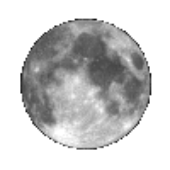Yes, it has a name. It is
Moon
Our Moon is unique in the solar system in that it is so large compared to the planet that it orbits. It is heavily cratered and has large, flat
maria which are found primarily on the Nearside. It was in these flat regions where the five of the six landing missions of Apollo did their surface
explorations. This animated map shows lunar maria and Apollo landing sites.
The Farside of the Moon contains virtually no maria. Since the highland regions of the Moon are essentially unchanged from its formation,
we can see the record of over four billion years of cratering. Most of the impact craters on the Moon were formed in the first billion years of its
history. Tens of thousands of lunar craters have been named. You have, no doubt, heard of the Man on the Moon. But have you ever seen the
Woman in the Moon?
Today the Moon is a dead place, without any trace of an atmosphere. Since it’s interior is semi-molten at best, and it rotates so slowly,
there is no native magnetic field on the Moon.
Other surface features are unique to the Moon.



Radius of the Moon: 1738 km
The Moon is approximately 1/4 the radius of the Earth. It’s
mass is 81 times less. That gives us the result that the
Moon is not the same density as Earth. It is not made of the
same stuff. We now know that the Moon has little heavy
metals such as iron. It is pretty much rock, right to the
center.
Rotation of the Moon
The Moon does spin once in 27.3 days. You should know
that we only see one side of the Moon from Earth. How can
that be if the Moon is rotating (spinning)? The answer is
that it spins as fast as it orbits. Virtually every other moon
in our solar system does the same thing. We say they are
tidally locked. These moons always face their central planet
as they circle around.
Orbit of the Moon: 27.3 days
The Moon orbits the Earth once in 27.3 days. This is the
same rate that it spins. Virtually every other moon in our
solar system does the same thing. We say they are tidally
locked. These moons always face their central planet as
they circle around.
Atmosphere of the Moon
The Moon has virtually no atmosphere, of course. When the
Apollo landing craft set down on the surface, their rocket
exhaust significantly increased the number of gas
molecules above the surface of the Moon!
Rotation of the Moon: 3476 km
The Moon does spin once in 27.3 days. You should know
that we only see one side of the Moon from Earth. How can
that be if the Moon is rotating (spinning)? The answer is
that it spins as fast as it orbits. Virtually every other moon
in our solar system does the same thing. We say they are
tidally locked. These moons always face their central planet
as they circle around.









































